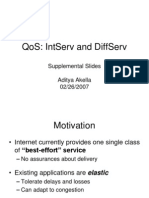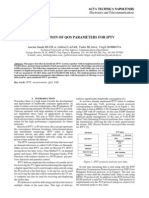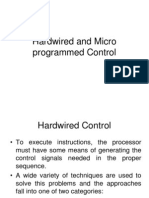QoS Queuing Methods PDF
QoS Queuing Methods PDF
Uploaded by
Malik Faisal KhanCopyright:
Available Formats
QoS Queuing Methods PDF
QoS Queuing Methods PDF
Uploaded by
Malik Faisal KhanOriginal Description:
Original Title
Copyright
Available Formats
Share this document
Did you find this document useful?
Is this content inappropriate?
Copyright:
Available Formats
QoS Queuing Methods PDF
QoS Queuing Methods PDF
Uploaded by
Malik Faisal KhanCopyright:
Available Formats
Name
FiFO PQ
Abbreviation for
First in First out
Method
No traffic classification. Packets flow one after the other. Traffic Classified and then scheduler services the high priority queue first compared to low priority queue.
Advantages
Simple and less processing involved.
Disadvantages
Applications
Priority Queuing
FQ
Fair Queuing
1-Simple and moderate processing. 2-Good for real time applications. Traffic Classified to different flows and traffic taken Bursty traffic can not take in round robin manner one by one. ( This avoids resources of the traffic in starvation of low priority traffic as in the case of PQ) other queues. ( this might happen in PQ)
Indiscriminate to class of services therefore Normal LAN applications not suitable if operator gives multiple class of service low priority queues can be starved if there is Best for real time excessive high Priority queue. applications like Voice and Video 1-Same bandwidth is assigned to all queues. Therefore not suitable if some traffic needs to take more bandwidth compared to others. 2-Not good for real time services. If packets in each queue has different length, one queue can take more resource since the bandwidth is counted in terms of number of packets Computationally complex to implement and calls for complex processing (Because it is a bit by bit processing) Since software based so slow and only suitable for edge nodes. Not suitable for Core router applications
WFQ
WRR or CBQ
Overcomes the problem of FQ. Provides guaranteed bandwidth to certain traffic flow. Also supports variable Weighted Fair Queuing length packets. Best then the others queuing methods in terms of providing guaranteed bandwidth. Traffic classified and weight is assigned to flows Hardware based and if the flows are of variable length, accurate Packets are taken one after the other in round robin computationally less complex bandwidth per class can not be guaranteed Weighted Round Robin OR fashion. If a packet flow weight is 2 times the Class Based Queuing weight of the another, twice the packets are taken during single round compared to the other flow. Same method as WRR but also takes into account the variable length of each flow. 1-More accurate bandwidth Not as precise end to end delay guarantees control compared to WRR if as other methods do. flows have packets of variable sizes. 2-Overcomes problem of WFQ by having lower computational complexity which can be implemented in hardware.
Traffic classified to different flows and then weight is assigned to the traffic to control the percentage of the bandwidth to the output port BIT by BIT. Traffic flows in round robin fashion. Supports variable length packets. A parcular type of WFQ is CBWFQ ( Class based) that can classify flows according to priorities
Software based and suitable for edge devices only. Not for Core devices.
Hardware based therefore suitable for core and edge applications
Hardware based therefore suitable for core and edge applications
DWRR
Deficit Weighted Round Robin
You might also like
- Concise Guide to OTN optical transport networksFrom EverandConcise Guide to OTN optical transport networksRating: 4 out of 5 stars4/5 (2)
- Maxwell General SizingDocument9 pagesMaxwell General SizingcsptolNo ratings yet
- Review:: Unit Iv: Intregrated and Differentiated Services Topic I: Integrated Services ArchitectureDocument10 pagesReview:: Unit Iv: Intregrated and Differentiated Services Topic I: Integrated Services ArchitectureNivethithaa DhanrajNo ratings yet
- The Application of RSVP: Jan Lucenius Research Scientist VTT Information Technology Email: Jan - Lucenius@vtt - FiDocument7 pagesThe Application of RSVP: Jan Lucenius Research Scientist VTT Information Technology Email: Jan - Lucenius@vtt - FiDONA MONDALNo ratings yet
- A Technical Analysis of QoSDocument4 pagesA Technical Analysis of QoSLone Grace CuencaNo ratings yet
- Providing Qos in Ip NetworksDocument41 pagesProviding Qos in Ip NetworksRandy DookheranNo ratings yet
- Report 4 QOSDocument5 pagesReport 4 QOShaniakhaled615No ratings yet
- IOSR JournalsDocument7 pagesIOSR JournalsInternational Organization of Scientific Research (IOSR)No ratings yet
- 19 A Comparative Analysis of Time StampedDocument6 pages19 A Comparative Analysis of Time Stampedbpratap_cseNo ratings yet
- IISRT Arunkumar B (Networks)Document5 pagesIISRT Arunkumar B (Networks)IISRTNo ratings yet
- Introduction To QoSDocument11 pagesIntroduction To QoSJose Luis JaramilloNo ratings yet
- QoS: IntServ and DiffServDocument41 pagesQoS: IntServ and DiffServRoberto Dell'OmoNo ratings yet
- Introduction To QoSDocument57 pagesIntroduction To QoSsheraz35No ratings yet
- Qos: Intserv and Diffserv: Supplemental Slides Aditya Akella 02/26/2007Document41 pagesQos: Intserv and Diffserv: Supplemental Slides Aditya Akella 02/26/2007mkamapNo ratings yet
- CN SeminarDocument12 pagesCN SeminarNavya SubramanianNo ratings yet
- Traditional Nonconverged Network: Traditional Data Traffic CharacteristicsDocument40 pagesTraditional Nonconverged Network: Traditional Data Traffic CharacteristicsCesar CriolloNo ratings yet
- 6CS029 Lecture 4 - QoS ConceptsDocument38 pages6CS029 Lecture 4 - QoS Conceptsdushantha.ellewalaNo ratings yet
- Qyality of ServiceDocument19 pagesQyality of Servicegeni1701dNo ratings yet
- Solutions To Chapter 10: Communication Networks (2Document24 pagesSolutions To Chapter 10: Communication Networks (2kzhaiderNo ratings yet
- Chapter 5 Quality of Services (QoS) - 102657Document15 pagesChapter 5 Quality of Services (QoS) - 102657PurvaNo ratings yet
- Quality of Service (Qos) & Techniques To Improve Qos: Presented By: Group 9Document28 pagesQuality of Service (Qos) & Techniques To Improve Qos: Presented By: Group 9KhushiiNo ratings yet
- Quality of ServiceDocument6 pagesQuality of Servicehassan IQNo ratings yet
- Overview of QoS in GeneralDocument6 pagesOverview of QoS in GeneralVũ LongNo ratings yet
- In The Field ofDocument10 pagesIn The Field ofak_netcoreNo ratings yet
- Unit 4 High Speed NetworkDocument8 pagesUnit 4 High Speed NetworkHarshit KumarNo ratings yet
- Unit-5 QoSDocument25 pagesUnit-5 QoSjhonNo ratings yet
- Computer Networks and Management: Integrated and Differentiated ServicesDocument51 pagesComputer Networks and Management: Integrated and Differentiated ServicesVenkatakrishnan NatchiappanNo ratings yet
- Voice-over-IP Performance in UTRA Long Term Evolution DownlinkDocument5 pagesVoice-over-IP Performance in UTRA Long Term Evolution DownlinkImen DebbabiNo ratings yet
- 09 QoSDocument55 pages09 QoSashwinlamroiaNo ratings yet
- Congestion Management Overview: Cisco IOS Quality of Service Solutions Configuration GuideDocument34 pagesCongestion Management Overview: Cisco IOS Quality of Service Solutions Configuration GuidekumarcscsNo ratings yet
- 12 Troubleshooting in Full-Fiber Access ScenariosDocument71 pages12 Troubleshooting in Full-Fiber Access ScenariosAbel PerezNo ratings yet
- Maipu 3230 QoSDocument42 pagesMaipu 3230 QoSErnestoDelgadoNo ratings yet
- Opportunist'ic Uplilnk Scheduling Systems: For 3GDocument5 pagesOpportunist'ic Uplilnk Scheduling Systems: For 3GFatmaLoussaiefNo ratings yet
- Evaluation of Qos Parameters For Iptv: Ancuta Sanda BUZILA, Gabriel LAZAR, Tudor BLAGA, Virgil DOBROTADocument6 pagesEvaluation of Qos Parameters For Iptv: Ancuta Sanda BUZILA, Gabriel LAZAR, Tudor BLAGA, Virgil DOBROTAFlorin NeaguNo ratings yet
- Computer Networks With Internet Technology William StallingsDocument54 pagesComputer Networks With Internet Technology William StallingsMary Amirtha Sagayee. GNo ratings yet
- Đa Phương Tiện Nâng Cao (Advanced Multimedia) : Qos Architectures Supporting MultimediaDocument34 pagesĐa Phương Tiện Nâng Cao (Advanced Multimedia) : Qos Architectures Supporting MultimediaDuc DuongNo ratings yet
- Jecet: Journal of Electronics and Communication Engineering & Technology (JECET)Document6 pagesJecet: Journal of Electronics and Communication Engineering & Technology (JECET)IAEME PublicationNo ratings yet
- Ip Qos Principles: Theory and PracticeDocument133 pagesIp Qos Principles: Theory and PracticeLuis Guillermo Muñoz MoralesNo ratings yet
- LTE QoS Guide - AricentDocument11 pagesLTE QoS Guide - AricentmatarakiNo ratings yet
- Chapter-2 - Burst Traffic AnalysisDocument10 pagesChapter-2 - Burst Traffic AnalysisalluseNo ratings yet
- End-2-End QoS Provisioning in UMTSDocument10 pagesEnd-2-End QoS Provisioning in UMTSnassr89No ratings yet
- Analysis of IP Network For Different Quality of Service: Ajith Kumar V. and Sheela Ganesh ThorenoorDocument6 pagesAnalysis of IP Network For Different Quality of Service: Ajith Kumar V. and Sheela Ganesh ThorenoorPham TiepNo ratings yet
- Chapter 5 QoS and Traffic ManagementDocument27 pagesChapter 5 QoS and Traffic ManagementShame BopeNo ratings yet
- Chapter 7Document17 pagesChapter 7Binod BashyalNo ratings yet
- 1.1-Introduction To QoS (Quality of Service)Document17 pages1.1-Introduction To QoS (Quality of Service)Yureka Mindset100% (2)
- Quality of ServicesDocument7 pagesQuality of ServicesVaishnavi TawareNo ratings yet
- High Speed NetworksDocument23 pagesHigh Speed NetworksSri Venkat0% (2)
- Dissertation Muehleisen 2015Document199 pagesDissertation Muehleisen 2015Nabil MesbahiNo ratings yet
- BW BenchmarkDocument22 pagesBW BenchmarkCentaur ArcherNo ratings yet
- Multimedia Transport Subsystem (Part 3) : Klara Nahrstedt Spring 2014Document18 pagesMultimedia Transport Subsystem (Part 3) : Klara Nahrstedt Spring 2014lizhi0007No ratings yet
- WCDMA Radio Resource Management: Huawei Technologies Co., LTDDocument42 pagesWCDMA Radio Resource Management: Huawei Technologies Co., LTDurfriendlyjoeNo ratings yet
- Integrated Services & Differentiated ServicesDocument47 pagesIntegrated Services & Differentiated Servicesparameshwari p100% (1)
- Performance Study of Multimedia Services Using Virtual Token Mechanism For Resource Allocation in LTE NetworksDocument5 pagesPerformance Study of Multimedia Services Using Virtual Token Mechanism For Resource Allocation in LTE NetworkswoodksdNo ratings yet
- Qos &flow CharacteristicsDocument16 pagesQos &flow CharacteristicsAbin JohnNo ratings yet
- Unit 4 - Computer Networking - WWW - Rgpvnotes.inDocument20 pagesUnit 4 - Computer Networking - WWW - Rgpvnotes.insusmitaNo ratings yet
- Congestion Control NotesDocument18 pagesCongestion Control NotesRushit DavdaNo ratings yet
- KTN NotesDocument24 pagesKTN NotesMelissa FinchNo ratings yet
- Improving SCFQ To Support Bursty TrafficDocument11 pagesImproving SCFQ To Support Bursty TrafficJohn BergNo ratings yet
- Networking Notes 1Document8 pagesNetworking Notes 1SAYAN DASNo ratings yet
- 1.1.1 LOFD-001027 Active Queue Management (AQM) : AvailabilityDocument7 pages1.1.1 LOFD-001027 Active Queue Management (AQM) : Availabilityvishwas20No ratings yet
- Gaudi 3 Ai Accelerator White PaperDocument24 pagesGaudi 3 Ai Accelerator White PaperMalik Faisal KhanNo ratings yet
- QoS Queuing Methods PDFDocument1 pageQoS Queuing Methods PDFMalik Faisal KhanNo ratings yet
- GMPLS ASON EssentialsDocument11 pagesGMPLS ASON EssentialsMalik Faisal KhanNo ratings yet
- Services ComparisonDocument1 pageServices ComparisonMalik Faisal KhanNo ratings yet
- Science P5 Revision Unit 22Document5 pagesScience P5 Revision Unit 22starsschooljktNo ratings yet
- System Reliability EvaluationDocument47 pagesSystem Reliability EvaluationOgik Parmana100% (1)
- Smartlock - Door Access ControlDocument2 pagesSmartlock - Door Access ControlAzmey Azyz PratamaNo ratings yet
- Leica Viva GNSS GS15 Receiver DS enDocument4 pagesLeica Viva GNSS GS15 Receiver DS endanielionut86No ratings yet
- Wireless Voting AbstractDocument4 pagesWireless Voting AbstractmanikmathiNo ratings yet
- User Manual lpc17xxDocument808 pagesUser Manual lpc17xxMichaelNo ratings yet
- Xtremedsp Solutions: Selection GuideDocument38 pagesXtremedsp Solutions: Selection GuideNithishkumar VenkatachalamNo ratings yet
- Chapter 4 Dec 50143Document47 pagesChapter 4 Dec 50143Kohilan VenugopalNo ratings yet
- Erl 89 42 PDFDocument127 pagesErl 89 42 PDFalbendalocuraNo ratings yet
- Hybrid V - V2Document1 pageHybrid V - V2PaulaNo ratings yet
- 12v Battery Charger Circuit With Auto Cut OffDocument4 pages12v Battery Charger Circuit With Auto Cut OffAbdul Wahab KhanNo ratings yet
- Exp 1 Induction To 8085 Micro PDocument10 pagesExp 1 Induction To 8085 Micro Phardik ChanderaNo ratings yet
- Ahi Manual 623ca68d27028892449626Document28 pagesAhi Manual 623ca68d27028892449626a20140011No ratings yet
- Professor Modisette What Are Oscilloscopes?: ECE 206LDocument13 pagesProfessor Modisette What Are Oscilloscopes?: ECE 206Lapi-437430069No ratings yet
- Practical Course For ATMEL MicrocontrollersDocument45 pagesPractical Course For ATMEL MicrocontrollersSubhash SumanNo ratings yet
- Hardwired and Micro Programmed ControlDocument40 pagesHardwired and Micro Programmed ControlShivani GargNo ratings yet
- Fire Alarm Control (IFC 640)Document84 pagesFire Alarm Control (IFC 640)thephuocNo ratings yet
- SGM8552 Single-Supply, Dual Rail-to-Rail I/O Precision Operational AmplifierDocument13 pagesSGM8552 Single-Supply, Dual Rail-to-Rail I/O Precision Operational Amplifierimran tahirNo ratings yet
- Hm-Pse-Ul DS 081902Document2 pagesHm-Pse-Ul DS 081902Mickie MayorNo ratings yet
- EVM4Document5 pagesEVM4PriyantanuNo ratings yet
- F6u14ae 6Document54 pagesF6u14ae 6sathiesh kumarNo ratings yet
- Item 22 - RL4 RelayDocument1 pageItem 22 - RL4 RelayTomsy ThomasNo ratings yet
- Otus 1: Single-Phase Electricity MeterDocument2 pagesOtus 1: Single-Phase Electricity Metersmart meter rusafaNo ratings yet
- RTLDocument10 pagesRTLThe SpiritualityNo ratings yet
- TVL ST23 04 Ad0Document9 pagesTVL ST23 04 Ad0coulsonpfilNo ratings yet
- CAD Cavity Model Analysis of High TC Superconducting Rectangular Patch Printed On Anisotropic SubstratesDocument4 pagesCAD Cavity Model Analysis of High TC Superconducting Rectangular Patch Printed On Anisotropic SubstratesHoucine HoucineNo ratings yet
- Three Phase Inverter With Synergy Technology: For EuropeDocument3 pagesThree Phase Inverter With Synergy Technology: For EuropeHakan ÇolakerNo ratings yet
- AutocorrelationDocument43 pagesAutocorrelationpondpakkaNo ratings yet
- Calculator For LTE Mobility EventsDocument42 pagesCalculator For LTE Mobility Eventsjunaid_ali_10100% (2)





























































































